Hiring a professional photographer elevates your real estate marketing and attracts more clients with captivating, high-quality listing photos. Real estate photography pricing varies depending on the location, photo type, requested services, and property characteristics. With prices generally ranging from $125 to $500, you must determine the most suitable pricing options for your needs and ensure your property stands out in the competitive market.
Read along as we review types of photography, price ranges, factors that affect pricing, and hiring tips for picking the right real estate photographer for your needs.
Types of Real Estate Photography & Pricing
Agents can boost their real estate marketing with various types of photography options, which include standard photography, immersive 2D and 3D photos, and stunning aerial drone shots. These visuals offer unique perspectives to attract more leads and make a lasting impression in the competitive market.
In addition to the type of photography, you must consider the right real estate photography pricing to fit your budget. Check out the differences between standard, 2D and 3D, and aerial drone photography as well as real estate photography cost ranges and examples below.
Standard Photography
When browsing property listings, standard photos are the go-to listing pictures that visitors will encounter. These images are typically one-dimensional and encompass essential areas of the property, such as the front and back, living room, kitchen, bathrooms, bedrooms, and other notable spaces within the home. The primary objective is to capture accurate property representations, giving potential buyers a glimpse of what they can expect during an in-person visit.
Regarding real estate photography rates, there are diverse pricing models available to choose from. Photographers can charge based on the number of photos, a comprehensive flat-fee package, or even the property size. Standard real estate photography rates offer faster turnaround times as these photos require minimal post-processing compared to aerial or 3D photography. Some pricing options may include post-processing within the package, while others may treat it as an additional cost.
We’ve identified standard photograph services along with approximate costs in the table below:
Services | Estimated Cost |
|---|---|
Basic (up to 10 photos) | $125 |
Standard (20 to 25 photos) | $175 |
Flat fee packages | $125 |
Pricing on homes up to 2,500 sq ft (square feet) | $200 |
Pricing on homes up to 7,000 sq ft | $350 |
In this example of standard real estate photography, the photo offers a captivating view of the property’s surroundings. Capturing the property at an angle provides depth, showcasing both the home’s size and the elegant curvature of the driveway, which would have been obscured in a straight-on shot. Moreover, the sunlight enhances the visibility of the brick detailing and window treatments, allowing viewers to appreciate the property’s intricate features.
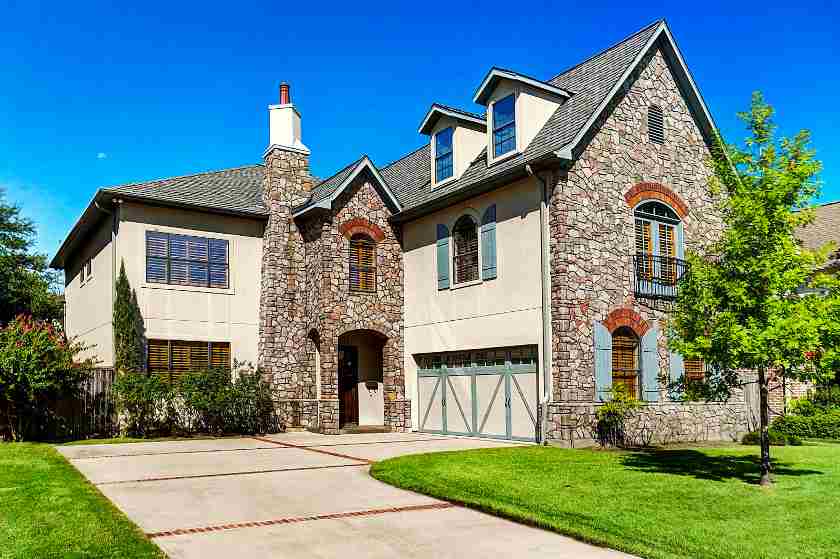
House built with bricks (Source: TK Images)
In this example of real estate photography, the photo emphasizes the room’s ample natural light and offers a delightful glimpse of the exterior view. The carefully chosen angle enhances the overall composition by providing a sense of depth, effortlessly guiding the viewer’s gaze through the room and toward the adjoining spaces.

Dining area with big windows (Source: TK Images)
Standard real estate photography captures the essence of a property by showcasing its unique features during both dawn and dusk. This twilight photo provides viewers with a distinct experience, particularly for clients accustomed to attending open houses during daylight hours. By offering a different perspective, dusk photography adds an extra touch of allure and allows potential buyers to envision the property’s ambiance and charm in a new light.
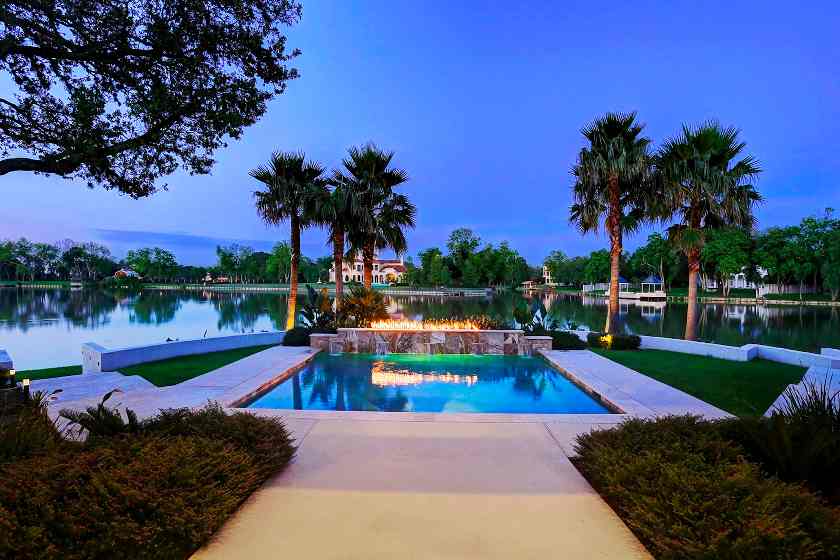
Photo of a property’s pool taken during dusk (Source: TK Images)

Listing freelancers (Source: Fiverr)
Photo editing services should be an essential part of any comprehensive photography pricing package. However, if they are not included, you can outsource the work to freelancers on platforms like Fiverr. For as little as $5, you can find thousands of skilled freelancers in the dedicated Photoshop editing category, ready to assist with tasks such as photo editing, retouching, and image manipulation. Fiverr also allows you to filter vendors based on Pro services, ensuring access to vetted professionals who offer high-quality editing services.
2D & 3D Photography
By integrating 2D (two-dimensional) and 3D (three-dimensional) images with traditional photography, you will be able to enrich clients’ comprehension of property layouts, stimulate their interest, and accelerate decision-making processes. This digital presentation of properties, whether inaccessible or under development, eliminates the necessity for in-person visits, accommodating clients who purchase without physically experiencing the property.
To provide transparency and clarity, check out the real estate photography pricing list for 2D and 3D photography found below. The pricing is based on the property’s square footage, ensuring that costs align with the size of the space being captured. These pricing structures allow agents and clients to evaluate the investment required and make informed decisions regarding the integration of 2D and 3D photography into their property marketing strategies.
Services | Estimated Cost |
|---|---|
2D color floor plans from 2,500-5,000 sq ft | $299 |
2D black-and-white floor plans from 2,500-5,000 sq ft | $350 |
2D black-and-white floor plans up to 2,500 sq ft | $250 |
3D virtual tour from 2,000-5,000 sq ft | $350 |
3D virtual tour from 5,000-8,000 sq ft | $450 |
3D virtual tour up to 2,000 sq ft | $250 |
3D virtual tour over 8,000 sq ft | $500 |
Asteroom 3D tour | $325 |
This comprehensive 2D floor plan accurately depicts the property’s layout, showcasing each room and its dimensions. Clients can visualize the spatial arrangement, understanding the flow and organization of the property. Details like the positioning of the stove relative to the sink are easily identifiable, allowing clients to assess their specific preferences for bedroom locations or closet sizes. The 2D floor plan is a valuable tool for clients to navigate their preferences and envision their ideal living space.
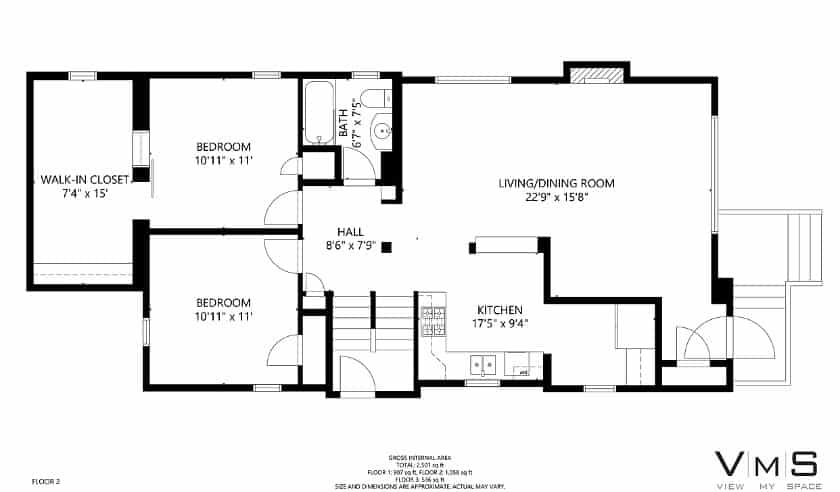
Sample floor plan printed in black and white (Source: View My Space)
In this example, viewers gain a bird’s-eye view of every room and can select and explore the areas they are most interested in. The dollhouse can be easily rotated, allowing for dynamic perspectives and a deeper understanding of the space’s layout and design. By incorporating such interactive experiences on your website, you not only extend the duration of visitors’ engagement but also showcase your commitment to staying at the forefront of technological advancements.

Sample 2D floor plan of a house (Source: View My Space)
A compelling approach to showcasing a 2D floor plan is through integrating 3D interaction, harnessing the combined advantages of both formats. An exemplary solution provided by Asteroom seamlessly merges the black-and-white 2D floor plan with interactive 3D elements. Viewers can access a clear visual representation of the floor plan and can also click into each room to embark on an immersive 3D virtual tour experience.
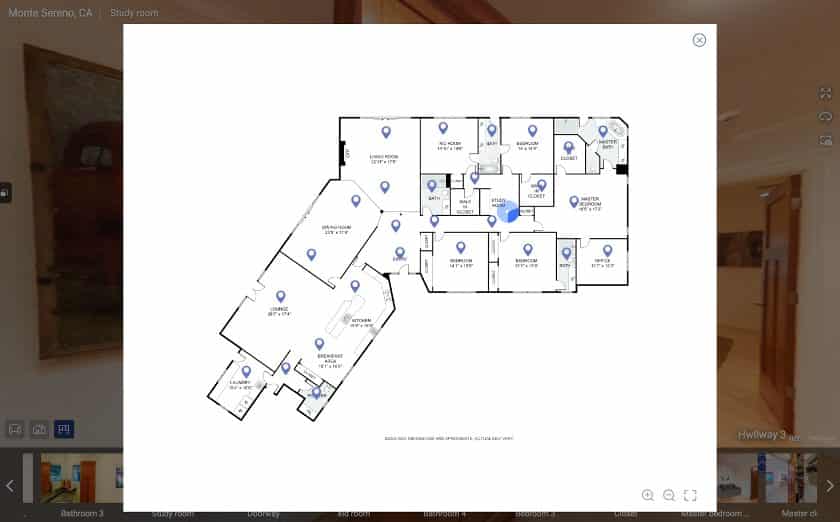
2D interactive floor plan (Source: Asteroom)
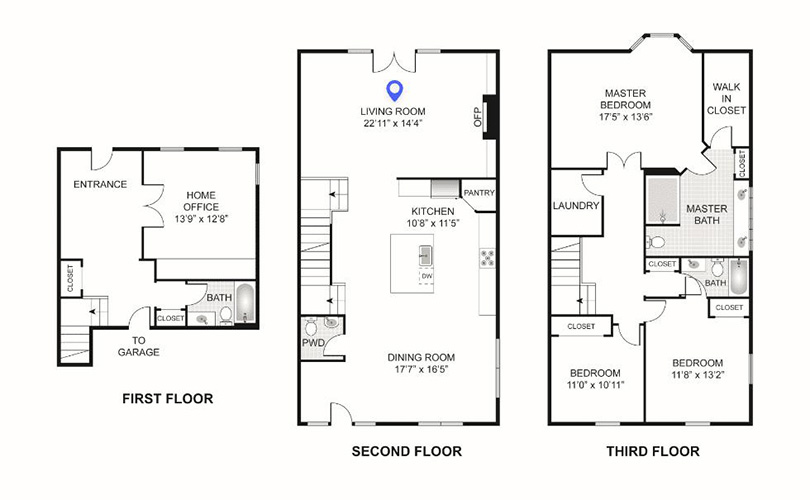
A floor plan shows the area of each room (Source: Asteroom)
Asteroom accommodates properties of any size and provides flexible photography options. Agents can capture images using Asteroom’s 3D tour kit and mobile phones, or hire a professional photographer through the platform for a flat fee. This dynamic solution empowers agents to offer engaging and realistic experiences to potential buyers, enabling interactive property tours.
Aerial Drone Photography
Aerial drone photography captures unique property features, providing valuable insights for clients. It showcases expansive grounds or scenic waterfront views, immersing potential buyers in the environment and helping them envision their future within the home. By adhering to Federal Aviation Administration (FAA) regulations, certified drone photographers ensure legal and safe operation, offering captivating aerial footage that enhances the overall marketing experience for real estate professionals.
When considering drone photography, it’s important to find vendors that align with specific needs. Pricing options vary, including fixed fees, hourly rates, or charges based on property size. By exploring available options, clients can make informed decisions that balance quality and affordability, resulting in stunning aerial shots of their properties.
Services | Estimated Cost |
|---|---|
Aerial drone photos of properties from 2,000-4,000 sq ft | $225 |
Aerial drone photos of properties up to 2,000 sq ft | $150 |
Aerial drone photos of properties over 5,000 sq ft | $300 |
10 aerial drone photos of the property exteriors | $250 flat fee |
5 aerial drone photos of the property exteriors | $150 flat fee |
Aerial drone video | $300 flat fee |
Aerial drone photography | $150 per hour |
This example showcases the home’s stunning mountain views and expansive undeveloped land, appealing to buyers seeking privacy and seclusion. With wider shots and a unique perspective, drones capture details beyond what ground-level photography can achieve.
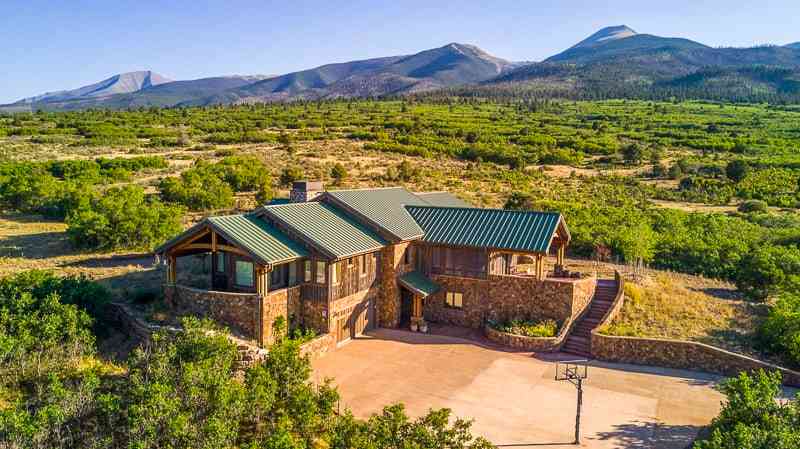
Aerial drone photography covers the whole landscape of the property. (Source: Dronegenuity)
The featured drone image below expertly highlights the property’s advantageous location near the water and neighboring properties. Furthermore, it captures the graceful curvature and length of the driveway, a detail that standard photography would struggle to convey. By encompassing multiple property features in a single shot, drone footage enriches storytelling, generating excitement and engagement among potential buyers.
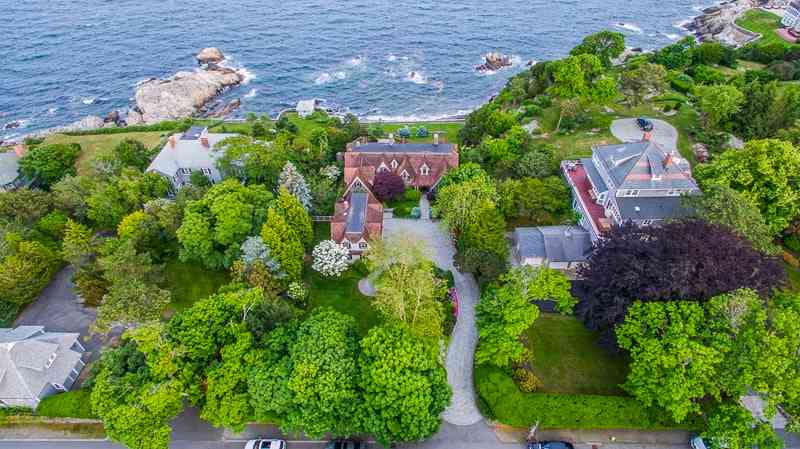
Aerial drone photography can show the property’s pristine location. (Source: Dronegenuity)
The aerial video of the Hudson Valley home beautifully showcases its exterior features, including the inviting pool, expansive double decks, meticulous garden, and intricate landscaping details. Attempting to capture these amenities solely with standard photography would result in overwhelming images, potentially discouraging viewers from exploring the entire album. By leveraging drone technology, the video provides a comprehensive and immersive experience of the property’s surroundings, enveloped by vibrant greenery.
Aerial drone video of a luxury home (Source: YouTube)
6 Factors That Affect Photography Pricing
When it comes to marketing properties effectively to be successful in real estate, the impact of high-quality visuals cannot be overstated. Various factors influence photography real estate pricing, and it’s crucial to have a clear understanding of these considerations when seeking professional real estate photography services. From the skills and expertise required to the necessary equipment and attention to detail, here are key factors that can affect the pricing of real estate photography:
1. Property Size & Complexity
Real estate photography cost is influenced by the size and complexity of the property. When it comes to larger properties, capturing them effectively requires more time and effort than it does for smaller properties due to the increased number of rooms, architectural details, and exterior spaces that need to be photographed.
Similarly, complex properties with distinctive features like expansive landscapes, swimming pools, or high-end amenities may necessitate additional equipment or specialized techniques, leading to adjustments in the overall cost.
2. Number of Images & Services Required
Different packages or photographers may offer varying options in terms of the number of images provided. Some packages may include basic editing and retouching, while others may offer additional services like virtual staging, twilight photography, or aerial/drone photography. The more images or services you need, the higher the pricing is likely to be.
3. Photographer’s Experience & Skill Level
Seasoned professionals with a track record of delivering high-quality real estate photography will typically charge more than those who are just starting in the industry. Experienced photographers bring a wealth of knowledge, expertise, and creative vision to the table, which can greatly enhance the final results.
4. Equipment & Technology
Real estate photo rates are influenced by the equipment and technology used. Photographers rely on professional-grade gear, such as cameras, lenses, lighting equipment, tripods, and editing software, to achieve high-quality results.
The expenses of acquiring and maintaining this equipment, including regular maintenance and upgrades, are considered when determining pricing. Moreover, photographers offering specialized services like drone photography may charge additional fees due to the higher costs and skill level required to operate such equipment.
5. Location & Travel Expenses
If the property is situated in a remote area or requires extensive travel, photographers may charge additional fees to cover transportation costs, accommodation, and time spent on travel. Conversely, properties in densely populated areas or where the photographer is based may have lower travel expenses, potentially resulting in more competitive pricing.
6. Usage & Licensing
Real estate photography prices can be influenced by the intended usage and licensing of the images. If you only need the photographs for a single property listing, the pricing may be lower than using them for multiple listings, advertising campaigns, or commercial purposes. It’s important to discuss your specific requirements with the photographer to understand any limitations or additional fees associated with usage and licensing, as licensing agreements can vary among photographers.
Tips to Hire a Professional Photographer
Investing in a professional real estate photographer is a wise decision that can save you valuable time and greatly impact real estate lead generation. With their expertise, expect an expedited listing process and faster property sales.
By establishing a mutually beneficial relationship with a photographer, you can access top-quality real estate photography and videos that effectively showcase your listings. A comprehensive real estate photography pricing guide will help you navigate the costs and select the services that best align with your needs, ensuring you receive the maximum value for your investment.
When hiring a real estate photographer, consider the following factors:
- Specialization in real estate: Ensure that the photographer specializes in real estate photography, as it requires specific skills distinct from lifestyle or headshot photography. Inexperienced photographers may include items or signs that can lead to rejection by third-party listing sites.
- Portfolio evaluation: Review the photographer’s past work to gauge the quality and style of their photography. A reputable real estate photographer should have an extensive gallery of real estate photos available for you to assess. Make sure their style aligns with your expectations.
- Value over affordability: While budgets are important in marketing your listings, selecting a photographer solely based on affordability may result in poor-quality photos that can negatively impact your marketing efforts. Weigh the return on investment when considering real estate photography pricing.
- Test multiple photographers: Having a few photographers on your vendor list is advisable. This allows for flexibility in case of scheduling conflicts or last-minute requests that a single photographer may not be able to accommodate. Test different vendors to determine which ones you prefer and distribute business accordingly.
- Prompt turnaround time: Consider the post-production and photo file delivery turnaround time. A photographer’s skills may be exceptional, but slow turnaround times can hinder your ability to list the property promptly.
- Clear expectations: Conduct a thorough walk-through with your photographers initially. Discuss your marketing ideas and provide them with a comprehensive understanding of your preferred style. Additionally, offer feedback once the photos are received to ensure future sessions meet your expectations.
- Suitable equipment: Beware of photographers who rely solely on their smartphones to capture listings. Ensure that your chosen photographer possesses the appropriate equipment to handle various environments. Different lighting conditions, such as cloudy or dusk settings, require specific equipment to capture the best shots. Working with a photographer equipped with professional gear will result in high-definition photographs of superior quality.
Although hiring a professional photographer will take a lot of stress off your plate, you also have the option of taking listing photos on your own. To make sure you’re taking the best photos to capture your real estate listing, read through our article: Real Estate Photography Tips, Equipment & Mistakes to Avoid.
Bottom Line
Each type of real estate photography outlined in this article offers unique perspectives that enhance the visual appeal of properties and attract potential buyers. However, the question “How much does a real estate photographer charge?” is essential. Since photography varies on multiple factors like location, size, and the experience and reputation of the photographer, it is always recommended to contact local real estate photographers for accurate pricing information tailored to your specific requirements.
Frequently Asked Questions (FAQs)
Real estate photography is a specific type of photography that focuses on capturing images of properties, such as houses, apartments, and commercial buildings. It is a specialized field within the broader category of architectural photography.
Real estate photography aims to showcase the property in the most appealing and informative way possible, highlighting its key features, layout, and overall aesthetic. Real estate photographers create high-quality images that accurately represent the property and attract potential buyers or tenants by using professional-grade cameras, wide-angle lenses, and proper lighting techniques.
Photography pricing can be structured in various ways, depending on the photographer’s preferences and business model. Common approaches include hourly rates, package pricing, and a la carte options. Hourly rates involve charging clients for the time spent on the shoot, editing, and any additional services. Package pricing offers predetermined bundles with specific services or coverage options at a set price.
A la carte pricing allows clients to customize their photography experience by selecting individual services or products and paying for them separately. Factors such as the photographer’s experience, location, equipment, and project scope also play a role in determining pricing. Ultimately, photographers should consider their costs, desired profit margin, market demand, and the value they bring to clients when structuring their pricing.